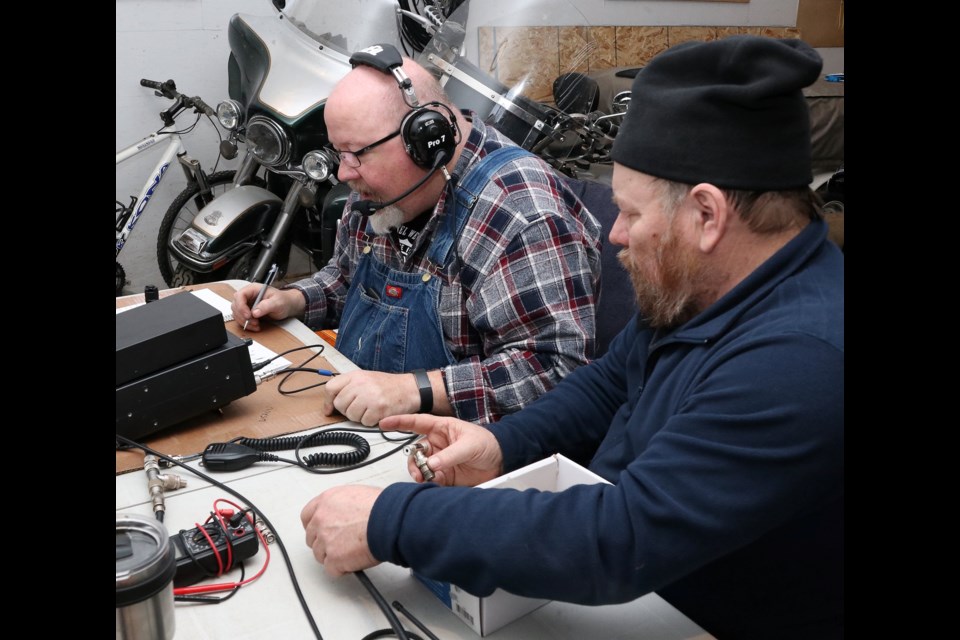The Moose Jaw Amateur Radio Club (MJARC), which has the distinction of being the first club in Canada to receive an station operating licence, is celebrating its 101st birthday this year.
Local amateur radio operators gathered at the YMCA on Nov. 16, 1921 and chartered the Moose Jaw Amateur Radio Association. The club adopted a temporary set of rules, while members elected W.R. (Wally) Pottle as president, Pay Bayley as vice-president, J.E. Brickett as secretary and A. Mathers as treasurer.
In 1922, the federal government issued the first station licence to the club and gave it the call sign 10AB, while members transmitted signals at 10 watts. This increased to 50 watts in 1923.
However, members found they could not afford to run the station and turned it over to the Kiwanis Club, which gave it back a year later. MJARC operated the station at 1200 kHz with 50 watts of power from studios in different locations, including the fire hall, YMCA building and Bellamy’s Furniture.
The father of CHAB
This continued until 1933, when financial issues forced the club to shut down the station. Commercial businessmen purchased it and returned it to the air as CHAB. This was probably for the best since, in 1934, the federal government forced all experimental stations to either obtain a commercial licence or shut down.
Today the club is known by the call sign VE5MA and is active with about 10 members.
While members have equipment at their homes, the club also has a station set up at the Western Development Museum and a room full of antique radio equipment used in homes, aircraft and military bases.
A fun hobby
Amateur radio — also known as ham radio — is appealing because it’s great talking with people worldwide without a cellphone or internet, said vice-president Frank Lloyd. He enjoys listening to AM stations throughout North America and the world, talking with people who still have CB radio, networking with others and engaging in a fun hobby.
“I’m a radio technology-based enthusiast playing with whatever catches my mind at the moment, depending on the day. Some days it’s HF — as in high-frequency — radios that can talk from here to Mexico or Australia … ,” he continued.
Ham operators require a licence because only a dozen radio bands are available, and the federal government regulates the airwaves.
Cost of equipment
People can purchase the “Volkswagen of radio” — usually older hand-held radios — for $30 if they lack money, while they could buy “the Ferrari of radio” — an ICOM unit for $2,800 — if they have cash, said Lloyd. What matters, though, is that operators — they don’t need to be tech-savvy — enjoy the hobby.
Pioneers of the internet
Long before the internet or texting by cellphone, Lloyd sent messages to others and vice versa using “an old, old computer,” a keyboard and radio signals.
He noted that anything sent through today’s internet was pioneered by amateur radio operators years ago. Today, electrical controllers turn messages or pictures into radio signals and send them to another receiver, where an antenna picks them up, and the controller on that end decodes them.
When a signal bounces off the ionosphere, a ham radio operator can reach someone in Alaska or Australia. Messages can also be sent to the International Space Station with the help of a nearly obsolete 30-year-old satellite.
When two stations contact each other, postcard-like QSL cards are exchanged between the parties to show they have connected, Lloyd said. Operators are excited to collect these cards, while there is even a contest to see who can acquire the most.
Learning by osmosis
Lloyd has been involved with amateur radio for 30 years. He jumped into the activity “by osmosis” because he was initially interested in AM broadcast radio and all the channels he could pick up. That interest progressed over the years before someone suggested he join a club.
He didn’t think much of it, but began listening to short-wave radio stations from BBC Foreign Service and Ecuador. That eventually led him to join the MJARC.
It also helped that he worked for SaskTel for 37 years and worked on older electronics.
Teaching others
As club vice-president, Lloyd teaches new members about ham radio and how to use the equipment. He enjoys watching their faces light up as they learn and discover a new world. Personally, he enjoys making contacts with people in places such as Great Britain, Australia and Hawaii.
“And I’m a bit of a radio-tinkering person … . I take things apart and put (them) back together,” he added.
Introductory classes usually happen once a year, and once people — regardless of age or sex — become members, club meetings occur on the third Tuesday of each month at Rodos Pizza at 7 p.m. Morning coffees are also held Saturdays at Humpty’s Restaurant on Thatcher Drive at 8 a.m.
Visit mjarc.ca for more information.




